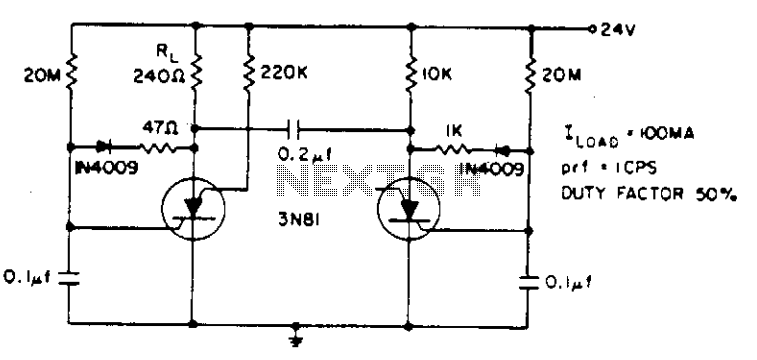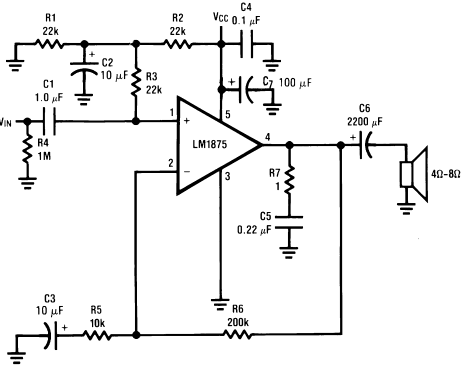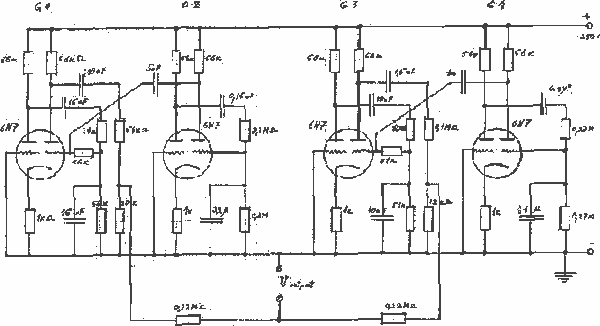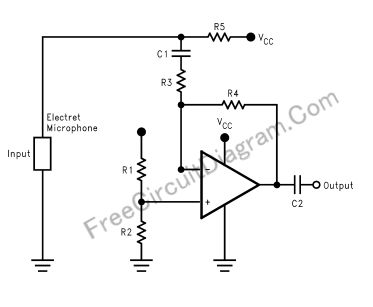
Low Power 12V Transformerless Power Supply
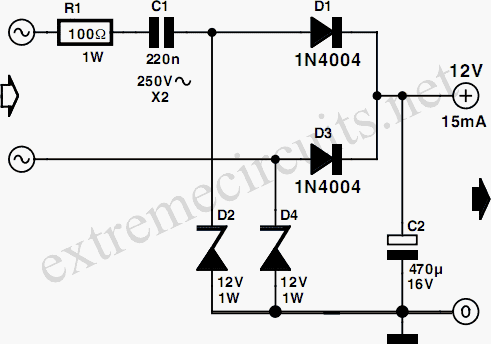
Many circuits can be powered directly from the mains with the aid of a series capacitor (C1). The disadvantage of this approach is that usually only one half cycle of the mains waveform can be used to produce a DC voltage. An obvious solution is to use a bridge rectifier to perform full-wave rectification, which increases the amount of current that can be supplied and allows the filter capacitor to be smaller. The accompanying circuit does this in a clever manner that uses fewer components. This design takes advantage of the fact that a Zener diode also functions as a normal diode, conducting current in the forward direction. During one half cycle, current flows via D1 through the load and back via D4, while during the other half cycle, it flows via D3 and D2. It is important to note that in this circuit (as well as in the bridge rectifier version), the zero voltage reference of the DC voltage is not directly connected to the neutral line of the 230-V circuit. Consequently, this type of supply is typically unsuitable for driving a triac, which usually requires such a connection. However, circuits utilizing relays can benefit from full-wave rectification. The supply voltage value depends on the specifications of the Zener diodes used, which can be chosen freely. Capacitor C2 must be rated to handle at least this voltage. The current delivery capacity is influenced by the capacitance of C1. With a capacitance value of 220nF, the current is approximately 15mA. A final warning: this circuit is directly connected to mains voltage, which can be lethal. It is crucial to ensure this circuit is housed safely within a suitable enclosure.
This circuit design allows for efficient power conversion from mains voltage to a usable DC output by employing a series capacitor and Zener diodes for rectification. The series capacitor (C1) is critical in limiting the current drawn from the AC mains, and its value can be adjusted according to the desired output current. The Zener diodes (D2 and D3) play a dual role; they rectify the AC input while also providing voltage regulation when the output exceeds a certain threshold. This arrangement allows for a more compact design compared to traditional bridge rectifiers, as it reduces the number of components required.
The rectification process occurs in two stages, where each half cycle of the AC waveform is utilized effectively. During the positive half cycle, current flows through D1, powering the load, and returning through D4. Conversely, during the negative half cycle, D3 and D2 allow current to flow in the opposite direction, again powering the load. This method ensures that both halves of the AC waveform contribute to the output, enhancing the overall efficiency of the circuit.
The output voltage is determined by the characteristics of the selected Zener diodes, allowing for flexibility in design. It is essential that capacitor C2 is rated for a voltage higher than the maximum expected output to prevent breakdown. The current available from this circuit is contingent upon the capacitance of C1; with a specified value of 220nF, the circuit can deliver around 15mA, which is suitable for low-power applications such as powering small relays or LED indicators.
Safety is paramount when working with mains-connected circuits. The design must incorporate adequate insulation and housing to prevent accidental contact with high voltage. It is advisable to use components rated for the voltages involved and to follow all relevant safety standards and regulations when implementing such a circuit. Proper enclosure will not only protect users but also ensure the longevity and reliability of the circuit's operation.Many circuits can be powered directly from the mains with the aid of a series capacitor (C1). The disadvantage of this approach is that usually only one half cycle of the mains wave-form can be used to produce a DC voltage. An obvious solution is to use a bridge rectifier to perform full-wave rectification, which increases the amount of current th
at can be supplied and allows the filter capacitor to be smaller. The accompanying circuit in fact does this, but in a clever manner that uses fewer components. Here we take advantage of the fact that a Zener diode is also a normal diode that conducts current in the forward direction. During one half wave, the current‚ows via D1 through the load and back via D4, while during the other half wave it‚ows via D3 and D2.
Bear in mind that with this circuit (and with the bridge rectifier version), the zero voltage reference of the DC voltage is not directly connected to the neutral line of the 230-V circuit. This means that it is usually not possible to use this sort of supply to drive a triac, which normally needs such a connection.
However, circuits that employ relays can benefit from full-wave rectification. The value of the supply voltage depends on the specifications of the Zener diodes that are used, which can be freely chosen. C2 must be able to handle at least this voltage. The amount of current that can be delivered depends on the capacitance of C1. With the given value of 220nF, the current is approximately 15mA. A final warning: this sort of circuit is directly connected to mains voltage, which can be lethal. You must never come in contact with this circuit! It is essential to house this circuit safely in a suitable enclosure. 🔗 External reference
This circuit design allows for efficient power conversion from mains voltage to a usable DC output by employing a series capacitor and Zener diodes for rectification. The series capacitor (C1) is critical in limiting the current drawn from the AC mains, and its value can be adjusted according to the desired output current. The Zener diodes (D2 and D3) play a dual role; they rectify the AC input while also providing voltage regulation when the output exceeds a certain threshold. This arrangement allows for a more compact design compared to traditional bridge rectifiers, as it reduces the number of components required.
The rectification process occurs in two stages, where each half cycle of the AC waveform is utilized effectively. During the positive half cycle, current flows through D1, powering the load, and returning through D4. Conversely, during the negative half cycle, D3 and D2 allow current to flow in the opposite direction, again powering the load. This method ensures that both halves of the AC waveform contribute to the output, enhancing the overall efficiency of the circuit.
The output voltage is determined by the characteristics of the selected Zener diodes, allowing for flexibility in design. It is essential that capacitor C2 is rated for a voltage higher than the maximum expected output to prevent breakdown. The current available from this circuit is contingent upon the capacitance of C1; with a specified value of 220nF, the circuit can deliver around 15mA, which is suitable for low-power applications such as powering small relays or LED indicators.
Safety is paramount when working with mains-connected circuits. The design must incorporate adequate insulation and housing to prevent accidental contact with high voltage. It is advisable to use components rated for the voltages involved and to follow all relevant safety standards and regulations when implementing such a circuit. Proper enclosure will not only protect users but also ensure the longevity and reliability of the circuit's operation.Many circuits can be powered directly from the mains with the aid of a series capacitor (C1). The disadvantage of this approach is that usually only one half cycle of the mains wave-form can be used to produce a DC voltage. An obvious solution is to use a bridge rectifier to perform full-wave rectification, which increases the amount of current th
at can be supplied and allows the filter capacitor to be smaller. The accompanying circuit in fact does this, but in a clever manner that uses fewer components. Here we take advantage of the fact that a Zener diode is also a normal diode that conducts current in the forward direction. During one half wave, the current‚ows via D1 through the load and back via D4, while during the other half wave it‚ows via D3 and D2.
Bear in mind that with this circuit (and with the bridge rectifier version), the zero voltage reference of the DC voltage is not directly connected to the neutral line of the 230-V circuit. This means that it is usually not possible to use this sort of supply to drive a triac, which normally needs such a connection.
However, circuits that employ relays can benefit from full-wave rectification. The value of the supply voltage depends on the specifications of the Zener diodes that are used, which can be freely chosen. C2 must be able to handle at least this voltage. The amount of current that can be delivered depends on the capacitance of C1. With the given value of 220nF, the current is approximately 15mA. A final warning: this sort of circuit is directly connected to mains voltage, which can be lethal. You must never come in contact with this circuit! It is essential to house this circuit safely in a suitable enclosure. 🔗 External reference

